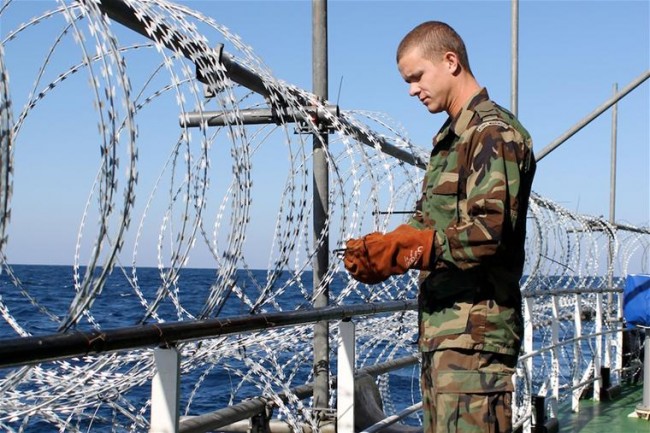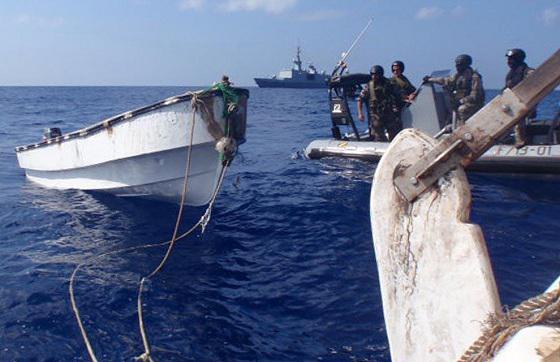I have hesitated in writing about the Psychological operations (PSYOP) planned and carried out during the United Nations intervention in Somalia simply because there are so many items to describe and so much data already written about that brief African adventure. The leaflets alone number close to 100, and if we add in the handbills, posters and other items, there are well over 100. I did write a short report entitled "A Brief Look at Propaganda over Somalia
American newspapers seem to get excited about wars and famines in foreign countries in cycles. At one time, they would write headlines and print numerous articles and editorials about the Guerrilla wars in Peru , Bolivia , Guatemala
We have seen the very same sort of cyclic activity when it comes to mass starvation, drought and famine in Africa . The newspapers will depict photographs of starving children with bloated bellies, weeping mothers, and bone-dry fields where nothing grows. It might be Ethiopia , the Congo , Somalia , or more recently, Liberia
In some ways, this is how the United States became involved in Somalia United States be part of that force, and slowly and gradually, the American military found itself unwillingly sucked into the vortex that is Africa .
A host of local petty warlords and clans ruled Somalia Mogadishu
The Army Times of 14 December 1992 lists the major warlords and their organizations:
Somali National Movement – Abdul Rahman Tur.Somali Salvation Democratic Front – Colonel Tusuf.
United Somali Congress (Aideed faction) General Mohammed Farah Aideed.
United Somali Congress (Ali Mahdi faction) Ali Mahdi Muhammed.
Somali National Front – General Mohamed Said Hersi Morgan.
Somali Patriotic Movement – Colonel Omar Jess.
First, a history of the United Nations political and military activity in Somalia
The United Nations in Somalia, United Nations Department of Public Information, April 1993, says:
The downfall of President Siad Barre on 27 January 1991 resulted in a power struggle and clan clashes in many parts of Somalia Mogadishu Mogadishu and spread throughout Somalia
An article entitled “Crisis in Somalia
The United Nations Operation in Somalia
 |
| General Mohamed Farah Aideed |
The fighting that followed, with clans and sub-clans constituted in loose alliances without central control, took place at a time of serious drought. That combination proved disastrous for the population at large. By 1992, almost 4.5 million people, more than half the total number in the country, faced starvation, severe malnutrition and related diseases. The magnitude of suffering was immense. Overall, an estimated 300,000 people, including many children, died. Some 2 million people, violently displaced from their home areas, fled either to neighboring countries or elsewhere within Somalia
Meanwhile, conditions within Somalia Somalia Mogadishu
Implementing the program proved difficult. Continuing disagreements among Somali factions on the United Nations role made the countrywide and more effective deployment of UNOSOM impossible. On 28 October, General Mohamed Farah Aideed declared that the Pakistani UNOSOM battalion must leave Mogadishu Mogadishu
The N.Y. Times of 2 January 1993 discusses the warlords:
General Aideed controls most of southern Somalia, including a large part of Mogadishu, while Mr. Ali Mahdi presides over northern Mogadishu…other key figures include General Mohammed Said Hersi Morgan who controls the town of Bardera, and Colonel Omar Jess, who controls Kismayu.
On 3 December 1992, the Security Council unanimously adopted resolution 794. The Council welcomed the United States offer to help create a secure environment for the delivery of humanitarian aid in Somalia United States
We should point out that before the actual start of military operations in Somalia the United States U.S. Army in Somalia
In response to the worsening famine, the United States decided to assist the relief efforts by airlifting food from nearby Kenya to remote airfields in the interior of Somalia United States U.S.
Problems of distribution within the country continued to hamper the relief effort. In the countryside, lawless gangs seized relief supplies and used them to buy local loyalties while letting thousands starve. In the cities, the warring political factions, supported by their private armies, amassed food stockpiles as bargaining chips and signs of their power. These rival entities, often barely controlled by their clan leaders, terrorized the international organizations, stealing food and killing whoever did not pay protection money.
The first elements of the Unified Task Force (UNITAF) came ashore on the beaches of Mogadishu Mogadishu Mogadishu U.S. U.S.
Over the next several weeks, eight tactical PSYOP teams accompanied UNITAF ground forces as they deployed throughout central and southern Somalia United States United States
On 3 March 1993, the Secretary-General submitted to the Security Council his recommendations for effecting the transition from UNITAF to UNOSOM II. He indicated that since the adoption of Council resolution 794 in December 1992, UNITAF had deployed approximately 37,000 troops in southern and central Somalia Somalia
The Security Council established UNOSOM II by resolution 814 on 26 March 1993. UNOSOM II took over from UNITAF in May 1993 and ended March 1995. It consisted of approximately 28,000 military and police personnel; there was also a provision for some 2,800 international and locally recruited staff. UNOSOM II was to complete, through disarmament and reconciliation, the task begun by UNITAF for the restoration of peace, stability, law and order. UNOSOM II was also entrusted with assisting the Somali people in rebuilding their economy and social and political life, re-establishing the country's institutional structure, achieving national political reconciliation, recreating a Somali State
PSYOP in Somalia
Looking at my own notes from 1992-1993, I see under “General Information” the following comments:
“UNOSOM was established 24 April 1992 to monitor the cease-fire, provide security, and escort humanitarian supplies to distribution centers. There were about 3,500 UN troops originally assigned. An additional 3,500 troops joined the force in August 1992 to protect convoys and distribution centers.
The United Nations authorized UNITAF on 3 December 1992. The United States
The United Nations authorized UNOSOM II on 3 March 1993. It was the first peacekeeping operation authorized to use force. The mission was to effect a political reconciliation and transfer of power to a civilian institution. The first force commander was Lieutenant General Cevik Bir of Turkey
The United Task Force Somalia
Turkish Lieutenant General Cevik Bir was appointed commander of the UNOSOM II force, with U.S. Army Major General Thomas M. Montgomery as his deputy. General Montgomery also retained his position as commander of U.S. Forces in Somalia Thus the U.S. forces retained their own national chain of command while inserting themselves into the UN structure. By October 1993 UNOSOM II consisted of over 16,000 peacekeepers from 21 nations. This number would jump to 29,732 soldiers from 29 nations by mid-November with the arrival of over 17,000 additional U.S. personnel as part of a U.S.
The 4th PSYOP Group published a book entitled Psychological Operations in Support of Operation Restore Hope in late 1993. It gives background on the early aspects of the operations:
PSYOP was a key Battlefield Operating System used extensively to support UNITAF operations. In order to maximize the PSYOP impact, we established a Joint PSYOP Task Force (JPOTF) under the supervision of the director of operations, and limited the PSYOP focus to the operational and tactical levels.
The JPOTF was comprised of approximately 125 members of the U.S. Army’s 4th PSYOP Group, and several of its subordinate battalions, the 8th (command and control), the 9th, (a tactical loudspeaker battalion), the PSYOP Dissemination Battalion and one U.S. Navy sailor and a dozen Somali linguists. The JPOTF worked with coalition forces, senior U.S.
A detachment of the 9th PSYOP Battalion was attached to the 2nd Brigade, 10th Mountain Division. The arrangement is described by Captain James C. Boisselle in an article entitled "Detachment B910 in Operation Restore Hope: Operations and Lesson Learned," in Perspectives - the Journal of the Psychological Operations Association, spring 1994. Some of CPT Boisselle's comments are:
The mission was to plan, coordinate, and execute PSYOP in support of the 2nd Brigade of the United Task Force campaign plan. The Brigade's initial focus was combat operations such as reaction to ambush, raid cordon and search...initially the role of tactical PSYOP in support of these operations was straight forward; induce surrender, deter resistance, and prevent civilian interference.
A day or two before the arrival of forces, the PSYOP plan was executed. This usually consisted of a leaflet drop explaining certain 'rules' and face-to-face messages conveying the US forces' operations. Once an area had been stabilized and relief supplies were again moving, Detachment B910 conducted follow-up assessments and developed programs to help achieve PSYOP objectives.
I should point out that the story does not end with the UNITAF leaflets. When UNOSOM II took over for UNITAF, they produced another entire series of leaflets, even more extensive than the UNITAF series.
The PsyWar Society published a booklet in April 1995 entitled Illustrated Catalogue of UNITAF Aerial Leaflets used in Support of Operation Restore Hope , Somalia
United States Marines CH-53 Sea Stallion helicopters dropped the first two leaflets (S1 and S2) over Mogadishu United States Air Force C-130 Hercules also dropped leaflets on Somalia Fort Bragg , NC , on the 4th PSYOP Group’s Heidelberg Somalia
The initial landing of U.S. forces in Mogadishu on 9 December was preceded by a drop of approximately 220,000 leaflets from a U.S. U.S.
Throughout the operation, PSYOP teams, using U.S. C-130s, U.S. Marine CH-53s, U.S. U.S. U.S. C-130s, leaflet missions were also conducted from New Zealand
 |
| Convoy Leaflet |
















